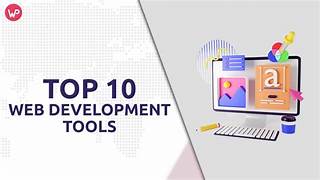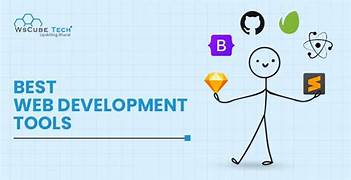In 2025, trending web development tools focus on efficiency and scalability. Frameworks like Next.js and Remix dominate for server-side rendering, while tools like Vite ensure faster builds. AI-assisted platforms like GitHub Copilot streamline coding. Webflow and Framer enable no-code design, while Tailwind CSS remains a favorite for styling. Bun.js gains traction as a fast JavaScript runtime alte
🚀 1. Next.js 14 (Full-Stack Framework)
Why it’s trending:
Next.js has become the top choice among React frameworks. With Next.js 14, developers can use server components, streaming rendering, and API routes that don’t need extra setup. This makes it simpler to create websites that load quickly and work well with search engines.
Key Features:
- Server Actions: Lets developers manage forms and server-side tasks without creating a separate API.
- Edge Functions: Provides super-fast serverless functions that run closer to users.
- SEO Optimization: Automatically handles page metadata for better search engine visibility.
Example Use Case:
- E-commerce Websites: Next.js is perfect for building fast, high-performing online stores that need quick loading and real-time updates.
🎨 2. Tailwind CSS 4.0 (Utility-First CSS Framework)
Why it’s trending:
Tailwind CSS is now the top pick for styling web apps in a simple and effective way. The 4.0 version adds new tools, better text sizing, and easier dark mode features.
Key Features:
- Utility-First Classes: Style your site quickly and keep it easy to manage.
- Dynamic Theme Support: Create websites with light or dark modes without hassle.
- Flexibility: Customize parts of your site without writing lots of CSS.
Example Use Case:
- Marketing Websites: Tailwind is great for making landing pages, portfolios, and blogs with little effort.
🖥️ 3. Astro 3.0 (Static Site Generator)
Why it’s trending:
Astro is a simple and fast tool for creating static websites. It makes websites load quickly by using less JavaScript.
Key Features:
- Partial Hydration: It only adds JavaScript to the parts of the website that really need it.
- Multi-Framework Support: You can use React , Vue , Svelte , and other tools with it.
- SEO and accessibility: It has built-in features to help your site rank better and be more user-friendly.
Example Use Case:
- Content-Heavy Sites: It’s perfect for blogs, documentation, and portfolios because it’s designed for static content.
🧩 4. Qwik (Resumable Framework)
Why it’s trending:
Qwik is a next-gen framework that focuses on resumability, ensuring pages load instantly and maintain performance over time.
Key Features:
- Resumable Apps: No hydration needed, resulting in faster loads.
- Edge-Ready: Works seamlessly with serverless platforms.
- SEO-Friendly: Built-in optimizations for better search engine rankings.
Example Use Case:
- Web Applications: Ideal for apps with high interactivity that need to maintain excellent performance
💻 5. Vite (Front-End Build Tool)
Why it’s trending:
Vite has quickly become the top choice for building modern front-end projects because of its super-fast HMR (hot module replacement) and efficient builds.
Key Features:
- Fast Development Server: Get instant updates while working on your project.
- ESM-Based: Uses modern ES modules for faster performance.
- Plug-in Ecosystem: Easily customize and extend its features with plug-ins.
Example Use Case:
- Single-Page Applications (SPA): Vite makes developing large SPAs much quicker and smoother.
🔧 6. Supa base (Open-Source Firebase Alternative)
Why it’s trending:
Supa Base is a free, open-source option similar to Firebase. It provides tools for real-time databases, user authentication, and storage.
Key Features:
- PostgreSQL Database: Easy to manage and can grow as needed.
- Real-Time Sync: Changes are automatically shown on the app or website.
- Authentication: ready-to-use tools for user login and security.
Example Use Case:
- SaaS Applications: Supa base works well for apps that need instant updates and a safe way to handle user logins.
🌐 7. Remix (Full-Stack Framework)
Why it’s trending:
Remix is a complete framework that focuses on making websites better and faster by using server-side rendering.
Key Features:
- Nested Routes: Simplifies routing and splitting code into smaller parts.
- Optimized for Performance: Uses streaming to deliver content faster.
- Built-In Data Fetching: You don’t need to create separate APIs for fetching data.
Example Use Case:
- Progressive Web Apps (PWA): Remix is perfect for building PWAs that load quickly and work offline.
🔒 8. Auth.js (Authentication Solution)
Why it’s trending:
Previously called NextAuth.js, Auth.js is now a widely-used tool for handling user authentication in modern web applications.
Key Features:
- OAuth Support: Works with services like Google, GitHub, Twitter, and more.
- Secure Sessions: Keeps user sessions safe and protected.
- Custom Providers: Allows you to add your own authentication methods easily.
Example Use Case:
- Membership Sites: Auth.js can help set up secure login systems for sites that offer paid memberships.
🤖 9. Chat GPT API (AI Integration)
Why it’s trending:
AI tools, such as the Chat GPT API, are making it easier for web developers to add conversational AI to their apps, enhancing user experience and interaction.
Key Features:
- Natural Language Understanding: Enables chat-based interfaces.
- Contextual Responses: Delivers tailored responses for users.
- Easy Integration: Compatible with multiple development frameworks.
Example Use Case:
- Customer Support: Adding a chatbot to an online store to manage frequently asked questions and customer inquiries.
🛠️ 10. Docker (Containerization Tool)
Why it’s trending:
Docker is still very important for modern web development because it helps developers set up the same working environment on different systems.
Key Features:
- Containerization: Makes sure apps work the same way in different places.
- Microservices Support: Great for splitting apps into smaller, manageable parts.
- CI/CD Integration: Makes it easier to continuously integrate and deploy apps.
Example Use Case:
- DevOps Pipelines: Docker is often used in DevOps to make deploying apps more automated.

🎉 11. Svelte Kit (Next-Gen Framework)
Why it’s trending:
Svelte Kit has gained popularity due to its lightweight nature and performance-first approach.
Key Features:
- Zero JavaScript by Default: faster initial loads.
- Server-Side Rendering (SSR): built-in support.
- SEO-Friendly: Ideal for public-facing websites.
Example Use Case:
- Corporate Websites: Svelte Kit is perfect for building fast, SEO-optimized company websites.

💡 12. Stra pi (Headless CMS)
Why it’s trending:
Stra pi is a well-known open-source headless CMS that helps developers create APIs and handle content easily.
Key Features:
- Customizable API: You can fully customize APIs without any limits.
- User-Friendly Interface: Even non-developers can manage content without trouble.
- Built-In Roles and Permissions: Keeps content management secure.
Example Use Case:
- Content Management Systems: Strapi works well for managing content in websites and mobile apps.
13. AI-Powered Development
Artificial intelligence (AI) is changing web development by doing tasks automatically, making coding more accurate, and creating personalized experiences for users.
- Chatbots and Virtual Assistants: Tools like Chat GPT and Google's Dialog Flow help developers add smart chatbots that offer quick customer support and tailored interactions.
AI-Driven Design Tools : Platforms like Adobe Sensei and WIX ADI use AI to create design layouts and suggest content, making the design process faster and easier.
Suggested link to read blogs: https://www.pansofic.com/blog/the-importance-of-responsive-design-in-modern-websites
14. Low-Code and No-Code Development
These platforms let users create apps with very little coding, making web development easier for everyone.
- No-Code Platforms : Tools like Webflow and Bubble let people design and launch websites and apps without needing to write code. This makes web development possible for people who aren’t developers.
- Low-Code Platforms: Platforms like Out Systems and Mendix offer a visual way to build apps with only a small amount of coding. This helps experienced developers work faster.
Conclusion:
In 2025, web development is all about speed, performance, scalability, and security. Tools like Next.js, Tailwind CSS, Vite, Supa Base, and Remix are changing how web apps are built, making them faster, more interactive, and simpler to maintain. Picking the right tools for your project depends on your needs, but keeping up with these trends will help you stay ahead in web development.
Suggested link to read blogs: https://www.pansofic.com/blog/the-importance-of-responsive-design-in-modern-websites